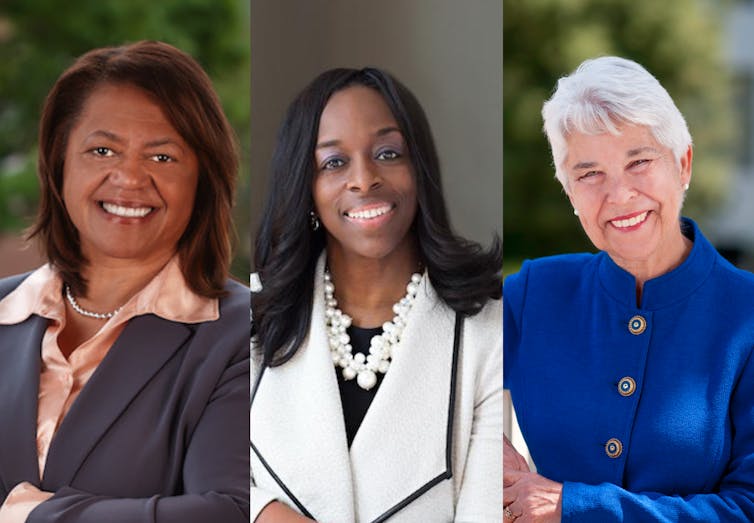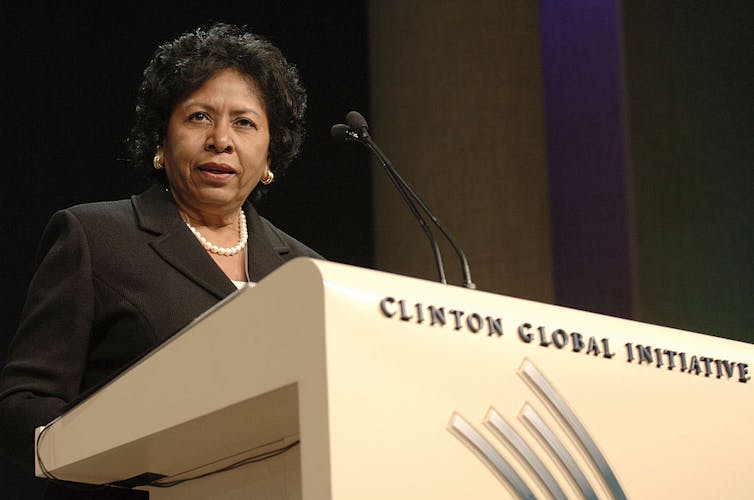Three Key Female Leaders in Higher Education
Womxn in Student Affairs
October 13, 2021
Female leaders in higher education have created more inclusive and open institutions – here are 3 key figures

From left to right, Michele Ozumba, Carmen Twillie Ambar and Carol Christ.
Thalia Plata, The Conversation
How have female leaders in higher education shaped the state of the field today, and what broader lessons can be learned from them? Recently, Carmen Twillie Ambar, president of Oberlin College and Conservatory, and Carol T. Christ, chancellor of the University of California, Berkeley, explored this question with Michele Ozumba, former president of the Women’s College Coalition and board member of The Conversation, during a webinar hosted by The Conversation. They approached the issue through the lens of “Junctures in Women’s Leadership: Higher Education,” a book the three edited jointly and to which they each contributed chapters. The speakers discussed trends in female leadership, practical advice and takeaways from the women they interviewed for their book. Below are the stories of three women the editors discussed, with edited remarks.
Women’s Transformative Power in Higher Education and Beyond.
1. Bernice Sandler – Opening the door for women in higher education
Bernice Sandler is honored at halftime as a champion of Title IX at the NCAA Women’s 2012 National Championship in 2012, at the Pepsi Center in Denver, Col. AAron Ontiveroz/The Denver Post via Getty Images
Starting their book with Bernice Sandler’s story was a purposeful decision, according to the editors. “Even though she wasn’t a university president, she offered a pathway for many of the women featured in the book because of her work on Title IX,” Ozumba remarked. Bernice Sandler has been nicknamed the “Godmother of Title IX” for her pioneering work in education.
Following completion of her doctorate at the University of Maryland, Sandler applied to a variety of teaching positions for which she was qualified, but kept getting rejected. She was told she “came on too strong for a woman,” Ozumba said.
While upsetting to hear, this comment eventually led Sandler to fight against sex discrimination and advocate for equal rights in education.
With the support of members of Congress, in 1972 Sandler helped shepherd the passage of Title IX, which prohibits sex-based discrimination in any school or other education program receiving federal funding.
“That groundbreaking work opened the door for this whole conversation around gender equity, as well as racial equity in higher education,” Ozumba said.
2. Ruth Simmons – Social change and authenticity
Ruth Simmons. Jemal Countess/WireImage via Getty Images
In 2003, Brown University became one of the first universities to address its relationship with slavery, thanks to then-President Ruth Simmons, the first Black president of an Ivy League university.
Simmons appointed a committee to investigate Brown’s history with slavery, a controversial decision that made headlines, according to Oberlin’s Ambar.
As the youngest daughter of sharecroppers born in rural Texas during the Jim Crow era of segregation, Simmons by her own account is “barely three generations removed” from her slave ancestors.
Her background is “part of her authentic self,” Ambar said, discussing her interview with Simmons.
The committee issued a report detailing Brown’s founders’ involvement in slavery and how it benefited the university, which led to implementation of several diversity initiatives.
“Almost every institution is thinking about [social] issues [now]. Ruth just did 20 years earlier,” Ambar said.
Ambar’s interview with Simmons not only helped her understand the impact of women in higher education but also informed her own leadership.
“She said [about her decision], ‘It didn’t feel bold, it just felt right.’ And it’s something that I keep on my mind a lot as a leader,” Ambar said.
3. Hanna Gray – The power of communicating
Hanna Gray. Bettmann/Getty Images
Hanna Gray, the first female president of the University of Chicago, stepped into that leadership role in 1978 at a time when the university was facing declining enrollment and financial troubles, according to UC Berkeley’s Christ.
In her interview with Christ, Gray acknowledged “the temptation to fix everything that’s wrong immediately.”
“But [she] understood that you have to be selective about your issues [and be able to] pick them well,” Christ said, recounting her interview with Gray. “And picking well depends both on understanding the landscape and higher education and also really understanding the institution that you’re leading,” Christ said.
According to Christ, a major reason behind her success as president was delegating and communicating with faculty at the university and understanding the governing structures in place already.
“Universities are very complex organizations and the authority tends to be really distributed,” Christ said in analyzing Gray’s success. “So if you want to create a major change, you have to be able to get people to join your parade and actually think that your parade is the best.”![]()
Thalia Plata, Editorial Intern, The Conversation
This article is republished from The Conversation under a Creative Commons license. Read the original article.


